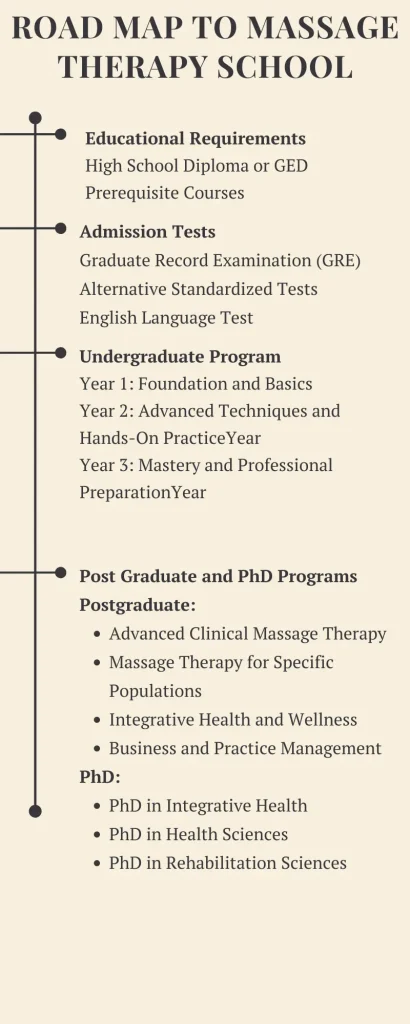How Long is Massage Therapy School? The duration of massage therapy programs typically ranges from 6 months to 2 years. Factors like full-time or part-time enrollment can affect this. These programs often include both classroom instruction and hands-on training, ensuring students are well-prepared for their certification exams and professional careers.
What is Massage Therapy School
It is an educational program designed to train individuals in the art and science of massage therapy. These programs cover a variety of techniques, including Swedish, deep tissue, and sports massage. Students learn about human anatomy, physiology, and the principles of therapeutic touch. Programs typically include both classroom instruction and hands-on practice, ensuring that students gain the necessary skills and knowledge to become certified massage therapists.

Massage therapy school also emphasizes the importance of professional ethics and client communication. Students are taught how to create a safe and comfortable environment for their clients, assess their needs, and develop customized treatment plans. Many programs offer flexible scheduling options, such as part-time or evening classes, to accommodate different lifestyles. Upon completion, graduates are prepared to take licensing exams and pursue careers in spas, wellness centers, clinics, or private practice.
How Long is Massage Therapy School
Year 1: Foundation and Basics
Semester 1: Introduction to Massage Therapy
Courses: Anatomy and Physiology I, Introduction to Massage Techniques, Ethics and Professionalism
Focus: Basic understanding of human body structures, initial exposure to massage techniques, foundational ethics, and professionalism in practice.
Semester 2: Core Techniques and Practices
Courses: Anatomy and Physiology II, Swedish Massage, Client Assessment and Documentation
Focus: Advanced anatomical studies, mastery of Swedish massage techniques, learning to assess client needs and maintain accurate records.
Year 2: Advanced Techniques and Hands-On Practice
Semester 3: Specialization and Diverse Techniques
Courses: Deep Tissue Massage, Sports Massage, Pathology for Massage Therapists
Focus: Specialized massage techniques, understanding of different client needs (e.g., athletes), study of common pathologies treated with massage.
Semester 4: Clinical Practice and Integration
Courses: Clinical Practicum I, Business Practices for Massage Therapists, Electives (e.g., Aromatherapy, Reflexology)
Focus: Hands-on experience in a clinical setting, learning business skills essential for running a practice, and exploring elective subjects for broader knowledge.
Year 3: Mastery and Professional Preparation
Semester 5: Advanced Clinical Practice
Courses: Clinical Practicum II, Neuromuscular Therapy, Advanced Client Communication
Focus: Further clinical experience, advanced techniques in neuromuscular therapy, honing communication skills for better client interaction.
Semester 6: Preparation for Certification and Employment
Courses: Board Exam Preparation, Professional Development, Internship/Externship
Focus: Intensive preparation for certification exams, professional development workshops, real-world experience through internships or externships.

How to Enter Medical School
Educational Requirements
High School Diploma or GED:
Most massage therapy schools require applicants to have completed high school or obtained a General Education Development (GED) certificate.
Basic Science Knowledge:
Some programs may prefer or require prior coursework in biology, anatomy, or health sciences.
Age Requirement:
Applicants are typically required to be at least 18 years old.
Entry Tests
Standardized Tests:
Most massage therapy schools do not require standardized tests like the SAT or ACT.
School-Specific Assessments:
Some programs may have their own entrance exams or assessments to evaluate a candidate’s aptitude for the field.
Basic Skills Test:
Tests may cover basic reading, writing, and math skills to ensure students can handle the academic demands of the program.
Application Process
Application Form:
Complete the application form available on the school’s website or admissions office.
Transcripts:
Submit official high school or GED transcripts.
Personal Statement:
Write a personal statement or essay explaining your interest in massage therapy and career goals.
Letters of Recommendation:
Provide letters of recommendation from teachers, employers, or professionals in the field.
Interview:
Some schools may require an interview to assess your commitment and suitability for the program.
Application Fee:
Pay the non-refundable application fee, which varies by institution.
Financial Aids
Federal Financial Aid:
Apply for federal aid by completing the Free Application for Federal Student Aid (FAFSA). Available options include Pell Grants, Direct Subsidized Loans, and Direct Unsubsidized Loans.
State Financial Aid:
Explore state-specific grants and scholarships which can often be found on your state’s education department website.
Institutional Scholarships and Grants:
Many massage therapy schools offer their own scholarships and grants based on merit, need, or specific criteria such as community service.
Private Scholarships:
Search for scholarships offered by private organizations, professional associations, and community groups.
Work-Study Programs:
Participate in federal or school-specific work-study programs to earn money while studying.
Payment Plans:
Many schools offer flexible payment plans that allow you to pay tuition in installments.
Post Graduate and PhD Programs
Post Graduate Programs
Postgraduate programs in massage therapy are designed for those who have already completed a foundational program and are seeking advanced skills, specialization, or leadership roles in the field.
1. Advanced Clinical Massage Therapy
Focus: Advanced techniques and clinical applications.
Coursework: Advanced neuromuscular therapy, myofascial release, trigger point therapy.
Duration: Typically 1-2 years.
Outcome: Certificate or diploma in advanced clinical massage therapy.
2. Massage Therapy for Specific Populations
Focus: Specialization in areas such as sports massage, prenatal massage, or geriatric massage.
Coursework: Tailored courses for specific client needs, anatomy, and pathology related to the population.
Duration: 6 months to 1 year.
Outcome: Certificate of specialization.
3. Integrative Health and Wellness
Focus: Holistic approaches combining massage therapy with other wellness practices.
Coursework: Integrative health practices, holistic nutrition, stress management techniques.
Duration: 1-2 years.
Outcome: Diploma or certificate in integrative health and wellness.
4. Business and Practice Management
Focus: Skills for running a successful massage therapy business.
Coursework: Business management, marketing, financial planning, ethics, and legal issues.
Duration: 6 months to 1 year.
Outcome: Certificate in massage therapy practice management.
PhD Programs
Currently, there are no direct PhD programs specifically for massage therapy. However, individuals interested in pursuing advanced academic and research roles in this field can consider related areas. These programs provide a strong foundation in research, education, and advanced practice.
1. PhD in Integrative Health
Focus: Research and leadership in integrative health practices, including massage therapy.
Coursework: Research methodology, integrative health theories, advanced clinical practice, dissertation research.
Duration: 3-5 years.
Outcome: Doctorate degree, leading to careers in research, academia, or high-level clinical practice.
2. PhD in Health Sciences
Focus: Advanced study in health sciences with an option to specialize in complementary and alternative medicine, including massage therapy.
Coursework: Advanced health science courses, research methods, specialization electives, dissertation.
Duration: 4-6 years.
Outcome: Doctorate degree, suitable for academic, research, and leadership roles in health care.
3. PhD in Rehabilitation Sciences
Focus: Advanced research in rehabilitation practices, including the therapeutic benefits of massage.
Coursework: Rehabilitation science theories, advanced therapeutic techniques, research design, dissertation research.
Duration: 4-6 years.
Outcome: Doctorate degree, preparing graduates for careers in research, higher education, and advanced clinical practice.
Top 10 Massage Therapy Schools
Choosing the right massage therapy school is crucial for gaining a quality education and launching a successful career. Here are ten highly regarded massage therapy schools in the United States:

1. Cortiva Institute
Locations: Multiple campuses nationwide
Programs: Comprehensive massage therapy training, continuing education courses
Highlights: Extensive alumni network, flexible scheduling, hands-on clinical experience
2. National Holistic Institute (NHI)
Locations: California (multiple campuses)
Programs: Massage therapy certification, advanced neuromuscular therapy program
Highlights: Focus on holistic health, career support services, extensive hands-on practice
3. Swedish Institute College of Health Sciences
Location: New York, NY
Programs: Associate in Occupational Studies (AOS) in Massage Therapy
Highlights: Over 100 years of history, comprehensive curriculum, urban clinical experience
4. Pacific College of Health and Science
Locations: New York, NY; San Diego, CA; Chicago, IL
Programs: AOS in Massage Therapy, continuing education
Highlights: Integrative health focus, experienced faculty, diverse student body
5. Arizona School of Integrative Studies (ASIS)
Locations: Tucson, Mesa, Flagstaff, Prescott, AZ
Programs: Massage therapy diploma, continuing education
Highlights: Emphasis on integrative techniques, small class sizes, personalized instruction
6. CenterPoint Massage & Shiatsu Therapy School & Clinic
Location: Minneapolis, MN
Programs: Massage therapy and shiatsu certification, advanced clinical massage program
Highlights: Dual focus on Western and Eastern modalities, professional clinic experience
7. Florida School of Massage
Location: Gainesville, FL
Programs: Massage therapy certification, continuing education
Highlights: Focus on body mechanics and awareness, experienced instructors, supportive community
8. Healing Hands School of Holistic Health
Locations: Escondido and Laguna Hills, CA
Programs: Massage therapy certification, holistic health practitioner program
Highlights: Emphasis on holistic health, diverse modalities, experienced faculty
9. East West College of the Healing Arts
Location: Portland, OR
Programs: Massage therapy diploma, continuing education
Highlights: Comprehensive curriculum, supportive environment, strong community connections
10. New York College of Health Professions
Location: Syosset, NY
Programs: Associate in Occupational Studies (AOS) in Massage Therapy, bachelor’s and master’s degrees in health sciences
Highlights: Focus on holistic health, experienced faculty, extensive clinical experience
Factors Affecting the Length of Massage Therapy School
The duration of massage therapy programs can vary significantly based on several factors. Understanding these factors can help prospective students choose a program that fits their needs and career goals.
1. Program Type
Certificate programs are typically the shortest, ranging from a few months to a year.
2. Enrollment Status
Full-time students can complete their programs more quickly, often within 6 months to 1 year.
3. State Licensing Requirements
Different states have varying requirements for the number of training hours needed to obtain a license. Some states may require as few as 500 hours, while others may require up to 1,000 hours or more.
4. Specialization and Electives
Programs offering specialized training in areas like sports massage, prenatal massage, or neuromuscular therapy may have additional coursework, extending the program length.
5. Clinical Practicum
Programs that emphasize extensive hands-on clinical training or internships may require more time. Clinical practicum hours can range from a few hundred to several hundred hours.
6. Curriculum Design
Some schools use a modular approach, where students complete one course at a time, which may lengthen the program.
Final Verdict
How Long is Massage Therapy School varies based on program type, enrollment status, state requirements, and specialization. By understanding these factors, prospective students can choose a program that aligns with their career goals and personal circumstances, ensuring a successful and fulfilling educational journey in massage therapy.
FAQs
1. How long does it take to complete a massage therapy program?
The duration ranges from 6 months to 2 years, depending on the program type, enrollment status, and state requirements.
2. Do I need a high school diploma to enroll in massage therapy school?
Yes, most programs require a high school diploma or GED for admission.
3. Are there part-time options available for massage therapy programs?
Many schools offer part-time options, allowing students to complete the program in 1 to 2 years.
4. What are the state licensing requirements for massage therapists?
State requirements vary, with training hours ranging from 500 to over 1,000 hours. Check your state’s specific requirements.
5. Can I specialize in a particular type of massage during my training?
Yes, many programs offer specializations such as sports massage, prenatal massage, or neuromuscular therapy, which may extend the program length.
